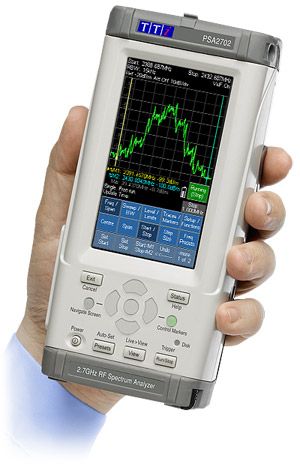As you’re aware, I’m an avid fan of Thurlby Thandar Instruments (TTi) line of handheld spectrum analyzers, having purchased nearly every model as they are released. One of my long-term wishes is that TTi produce an analyzer with an upper range of 6 GHz. Well, my wishes have been met in their newly released model PSA6005! As I travel a lot in my job, I like to take the minimum amount of test equipment possible. Unfortunately, most good quality analyzers in this frequency range are usually large, heavy and expensive. About 15 years ago, I ran into the their model PSA2701T and have used it extensively. In May 2013, TTi completely redesigned and repackaged this analyzer and released it as the PSA2702T. This summer, they upped the bar and released both a 3 and 6 GHz model. This review covers their new high-end PSA6005, which uses the same redesigned package.
Overview
Much of the functionality and specifications remain the same as the older model PSA2702T, but it covers 10 MHz through 6 GHz. TTi sells a lower-cost unit, the PSA3005, which is similar in specs, but has an upper frequency limit of 3 GHz. The new series analyzers include many more resolution bandwidths (RBWs) from 300 Hz to 10 MHz in a 1:3:10 pattern. Video bandwidths may be adjusted over the same range or locked to the RBW. The vertical scale can be 1, 2, 5 or 10 dB per division. This is a substantial improvement in the PSA2702T RBWs of just 15 kHz, 280 kHz and 1 MHz. There are two markers that can read out amplitude and frequency, as well as delta. Limit lines may be defined and the unit may be programmed to beep, stop the sweep, log the sweep, or provide an output pulse if the limit is exceeded. Free PSA Manager software is provided that can control much functionality and display waveforms. Used in conjunction with Option U02, it provides a very powerful tool.
General
The unit can display amplitudes in dBm, dBuV, mV or uW and there are four reference levels: +20, 0, -20 and -40 dBm an improvement over the two levels for the PSA2702T of 0 and -20 dBm. The unit includes detectors for Alternate Peak (default), Negative Peak, Positive Peak, Sample, Linear Average, Log Average and RMS. Amplitude and frequency accuracy is reasonable for a unit this size and are fine for general troubleshooting purposes. However, you’d want to move to a lab-grade analyzer for the most accurate measurements or compliance testing. Setup configurations may be saved and recalled and the screen may be captured and stored in internal memory or USB thumb drives. At this point, not all thumb drives are supported, however. Only ones that conform to the USB Mass Storage Class (MSC) and have capacities from 32 MB to 32 GB will work. I had to try a handful before I found one that would work for me. Further details on this are included in the manual.
I love the clean design of the newer model. The new model has a large 5.5 by 9.5 cm (4.3-inch) backlit TFT LCD display with a useable waveform display area of 5.5 by 5.5 cm (2.25-inch square). The remaining portion of the display is devoted to status indicators and a three-tiered menuing arrangement. I like the fact the nested menus are always visible and I rarely have to guess where to find a function. The display is clear and easily readable. The new model also comes with a hinged protective cover that can snap off and remount to the rear to prop up the unit. The Li-Ion battery seems to last for weeks. I’ve only had to charge mine about once a month to top it off.
For more detail: 6 GHz spectrum analysis in your hand!

